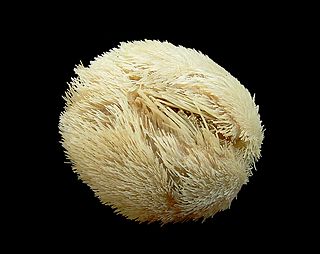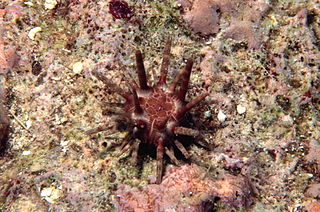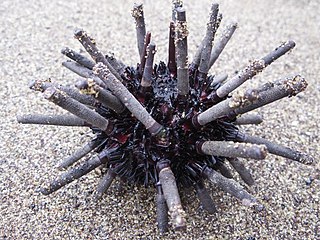
Sea urchins or urchins are typically spiny, globular animals, echinoderms in the class Echinoidea. About 950 species live on the seabed, inhabiting all oceans and depth zones from the intertidal to 5,000 metres. Their tests are round and spiny, typically from 3 to 10 cm across. Sea urchins move slowly, crawling with their tube feet, and sometimes pushing themselves with their spines. They feed primarily on algae but also eat slow-moving or sessile animals. Their predators include sea otters, starfish, wolf eels, and triggerfish.

The Diadematidae are a family of sea urchins. Their tests are either rigid or flexible and their spines are long and hollow.

Cidaris is a genus of pencil sea urchins.

Eucidaris tribuloides, the slate pencil urchin, is a species of cidaroid sea urchins that inhabits littoral regions of the Atlantic Ocean. As a member of the basal echinoid order Cidaroida, its morphological, developmental and molecular genetic characteristics make it a phylogenetically interesting species.

Heterocentrotus trigonarius, commonly known as the slate pencil urchin or red slate pencil urchin, is found in the tropical waters of the Indo-Pacific region. Heterocentrotus mamillatus is a similar, related species.
Slate pencil urchin is a common name for several sea urchin species with blunt spines:

Cidaroida, also known as pencil urchins, is an order of primitive sea urchins, the only living order of the subclass Perischoechinoidea. All other orders of this subclass, which were even more primitive than the living forms, became extinct during the Mesozoic.

Cidaridae is a family of sea urchins in the order Cidaroida.

Echinocardium cordatum, also known as the common heart urchin or the sea potato, is a sea urchin in the family Loveniidae. It is found in sub-tidal regions in temperate seas throughout the world. It lives buried in the sandy sea floor.

Sphaerechinus granularis is a species of sea urchin in the family Toxopneustidae, commonly known as the violet sea urchin, or sometimes the purple sea urchin. Its range includes the Mediterranean Sea and eastern Atlantic Ocean.

Echinidae is a family of sea urchins in the order Camarodonta. Members of the family are found in the Atlantic Ocean and the Antarctic.

Holasteroida is an order of irregular sea urchins.

Eucidaris metularia, the ten-lined urchin, is a species of sea urchins in the family Cidaridae. It is found in shallow parts of the Indo-Pacific Ocean and is characterised by its sparse covering of banded, flat-tipped spines.

Eucidaris thouarsii, the slate pencil urchin, is a species of cidaroid sea urchins that inhabits littoral regions of the East Pacific Ocean.
Sabinella troglodytes is a species of small sea snail, a marine gastropod mollusk in the family Eulimidae. It is a parasitic snail found near the coast of Brazil which lives on the body of the slate pencil urchin Eucidaris tribuloides.

Dermechinus is a genus of sea urchin in the family Echinidae found in deep water in the southern Indian, Pacific and Atlantic Oceans. It is monotypic, with Dermechinus horridus, sometimes called the cactus urchin, being the only species.

Parechinus angulosus, the Cape urchin, is a sea urchin in the family Parechinidae endemic to southern Africa. It is the only species in the genus Parechinus.

Goniocidaris is a genus of sea urchins (Echinoidea) in the family Cidaridae and typical of the subfamily Goniocidarinae. Extant species are mostly found in Indo-Pacific seas, often living at depth.

Eucidaris galapagensis, commonly referred to as the slate pencil sea urchin, is a species of echinoderms in the family of Cidaroid. This sea urchin lives in coastal areas in the Galapagos, Clipperton, and Cocos. The preferred substrate of these organisms is rocky, benthic environments that provide refuge. In fact, greater abundance of Slate Pencil Sea Urchins is correlated with correct substrate, as well as greater food availability. Their diet is primarily herbivorous, however, they also consume various invertebrates. They graze heavily on live corals and algae in open, shallow reef habitats. Their grazing schedule is not restricted to sunlight availability, and will graze nocturnally. Their diversity in diet is a result of their metabolism, as they are capable of remarkably efficient assimilation of nutrients. Pencil Slate Sea Urchin's crawl omnidirectionally in their environment. Additionally, they are able to sense surrounding light by photoreceptor cells that act as their visual system.


















